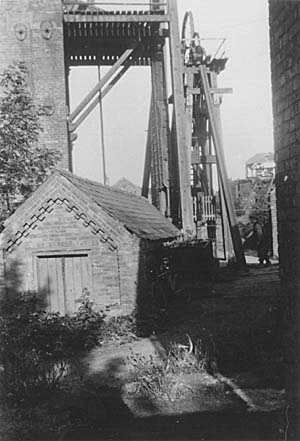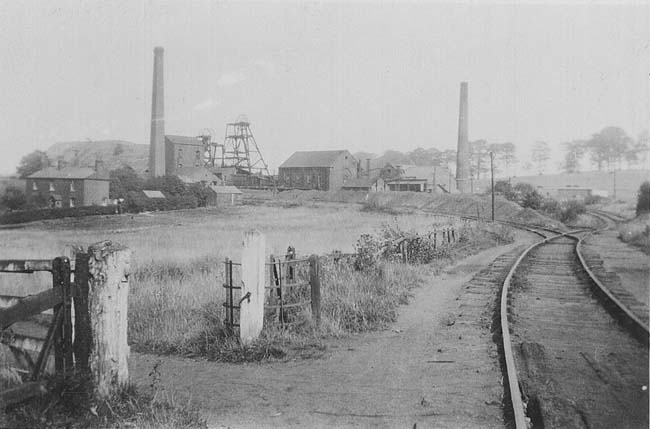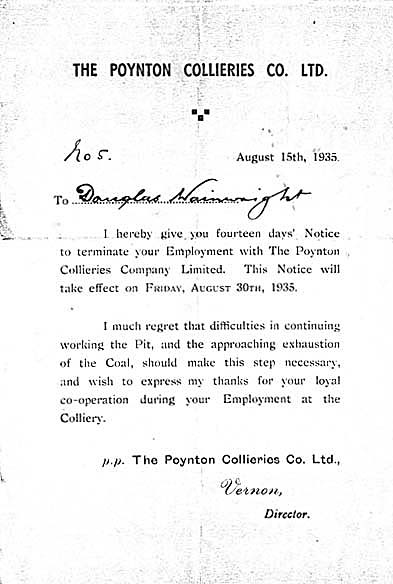
1890-1935 The final years
With the opening of the Lawrance Pit which was the last new sinking at Poynton, the collieries entered the last phase of their long life. It is for this period that least information is available as the annual reports have not survived after 1897 and the story after 1900 has proved a little thin on concrete facts. Two incidents that have been recorded occurred in 1891 at the Oval Pit. In February of that year two tubs fell out of the cage and smashed down into the sump and in December a cage came off its guides. Both incidents led to the men having to come up at the Anson Pit. 14
During 1891 the new pit became the largest producer with 105,283 tons worked, whilst Oval Pit raised 73,120 tons and Anson 72,140 tons. In the next year Lady Pit was also brought back into production working the Accommodation Seam in order to compensate for falling output at the Anson Pit. A new two cylinder winding engine was installed and the cage was counterbalanced by a cage in the Lord Pit shaft filled with rocks. In March 1892 Greenwell was already noting.
"It will be seen that the Average Working Cost gradually increased during the year. This was due to increased workings at both the Anson and Park Oval Pits in seams of Coal which are more expensive to work and lessened workings in seams which are cheaper to work. The Accommodation seam at both these pits is coming very nearly to an end and we are obliged to make up the quantity in the Gees and Three Feet or Reform seams both of which are thinner and more expensive to work than the Accommodation." 15
Further problems were soon to appear when the adjoining Norbury Collieries closed at the expiry of their lease from Lord Newton. "At this Colliery, when working, a considerable quantity of water had to be dealt with and now that pumping has ceased this water is gradually rising in the old workings and sooner or later, probably very soon, will find its way into the Poynton workings through communications which were made in the upper Seams of Coal when the two Collieries were worked together some years ago by Messrs. Wright & Clayton.
The quantity is not a very serious one but added to the large quantity which we already haw to deal with, it would be a great source of anxiety without further pumping appliances, these always bring a danger of break downs at the Lady Pumping Establishment such as have several times occurred in the past". 16
Greenwell suggested that an inflow of 150 gallons of water per minute was to be expected from Norbury and proposed installing pumping equipment capable of raising 500 gallons per minute at the Park Pits. The estimated cost was £2500 which was in fact very close to the final price when it was installed in 1894/5. In fact the water did not enter the Poynton workings when expected and permission was gained from the Norbury estate to drive levels in the Gees Seam to tap it. The levels reached the water in June 1896 by which time it stood at 543 feet deep in Norbury Pit and by early 1897 the level had been dropped by 37 feet. Further tunnels were driven in the Reform seam to lower the level more quickly.
 |
|
| Lady Pithead,1935. The small building contained the balance bob for the pump rods |
The new pump proved its worth soon after installation as in October 1895 the Lady Pit pump burst its cylinder jacket causing considerable damage to other parts of the engine. Repairs were not completed until March 1896 and water was wound in barrels at the Lady Pit whilst the pumps at Park Pit were worked non-stop.
G.C. Greenwell Senior resigned his last connection with the collieries, that of Consulting Engineer, at the end of 1896 and his son deftly added his £100 per annum fee to his own salary.
In 1897, the last year for which reports survive, output was as follows: Anson Pit 54,302 tons, Park Oval Pit 57,153 tons, Lawrance Pit 108,396 tons and Lady Pit 24,665 tons. Profits were only £9590 which reflected a sharp drop in price which had fallen from an average of 7s 10.375d per ton in 1890 to 5s 9¼d in 1897.
The steady exhaustion of reserves led to the reopening of the Quarry Pit in 1900. Coal was raised from the Two Foot seam which occurs in the vicinity of Quarry and Lady Pit from which this seam was also worked. This seam was only about 40 yards deep at Quarry Pit and the smallwinding engine was fed with steam from a vertical boiler placed next to the stream on the opposite side of Anson Road with pipes over the road at high level. This working only employed about ten men underground and was stopped in 1907 with abandonment of the seam and Quarry Pit in 1910 as "temporarily unprofitable".
Water problems continued to mount and late in 1909 the Norbury water at last found its way through the old workings and into the Poynton Collieries. A major disaster was only averted by the fact that this occurred at a time when nobody was working underground. 17
Coal production in Cheshire was declining rapidly in the early years of the twentieth century and Poynton saw a similar although lesser fall. In 1897 Poynton produced 244,516 tons or about one third of the county total whilst in 1915 the figures were Cheshire 280,175 tons, Poynton 175,155 tons with 451 men underground. Thereafter the decline continued at Poynton with production falling to only 91,286 tons in 1921 when there was a long strike, and 80,146 tons in the year of the general strike. The 1926 strike lasted for 17 weeks in Poynton and the men went back to work after Lord Vernon explained that the Collieries would otherwise be closed due to the cost of pumping.
During this period of decline the colliery management underwent considerable change. Lord Vernon relinquished complete control of the pits and Poynton Collieries Ltd. was formed in 1921 with George Harold Greenwell, the son of G.C. Greenwell Junior, as agent. Very little is known about those involved in the company but no doubt some capital was introduced in an attempt to arrest falling profits by improving efficiency.
 |
| Park Pits, 1926. Screens (r centre), fan engine house (lower r), old railway incline (centre) |
 |
| Park Pits, c1930. Note tall engine house, Oval Pit and lower engine house, Lawrance Pit. |
The Oval Pit was the next to close in 1928 as the coal there was also exhausted,
leaving the Lawrance as the last Poynton pit to raise coal. Output was now only
70-80,000 tons per year and falling as the Accommodation Seam ran out. The quantity
was made up with some coal from the Arley Seam and the Ten Foot which was of
indifferent quality but the one pit was now having to bear the ever increasing
pumping costs. Water was being pumped at Lady Pit, Park Pits, and Canal Pit,
a situation which could not be economic for long.
 |
|
The final closure came Friday, 30 August 1935 when some 250 men were made redundant. One of the oldest employees at the time was Mr. Alfred Wood of Park Lane who had worked for the Collieries for 61 years, finally as a clerk at Towers Yard. Work for about 80 men was offered at a colliery in Kent but very few took up the opportunity. Fortunately jobs were available for some at A.V. Roe's factory at Woodford and several schemes including road work for the County Council helped to reduce the impact of the closure. The output of coal in the last eight months was 41,090 tons with a value of £25,267. Some men were kept on for a while to assist with the removal of scrap material from below ground but the cost of pumping was such that much cable, rail etc., was left down the pits. Within two weeks of pumping ceasing the water had risen to within a few feet of the top of the Park Pit Shafts and the workings were abandoned for good. All the surface plant was scrapped by Marlowes of Dukinfield during the next year leaving just the shells of engine houses etc, spoil heaps and the shafts as reminders of Poynton's main industry for some 150 years.
In the following years nearly all the buildings have been demolished, leaving
only the Lady Pit winding engine house and capstan house to remind us of the
Collieries. Anson Pit shaft collapsed in the 1950s and was filled with rubbish
and rubble. Of the other shafts most have been filled in although some lingered
on into the 1980s. Walker Pit, one of the older shafts, was capped by the National
Coal Board in 1981 whilst Park Pits were capped in July and August 1982, leaving
only the Lower Vernon Pit shaft uncapped or filled. The most obvious reminders
of the industry are the spoil heaps or 'dirt rucks' as they are known
locally. Anson Pit dirt ruck is the best surviving example and it still retains
traces of the trackbed for the tubway which climbed to its summit. At Park Pits
the spoil has been subject to speculators extracting shale for roadbuilding
and more recently a washing plant removed much of the small coal that was mixed
in with the shale and this was sold to the Central Electricity Generating Board
for use at Carrington Power Station. Poynton coal was therefore still proving
useful and providing electric power during the 1980s.
References and Notes
1. Down, C.G. and Warrington, A.J. The history of the Somerset coalfield.
David & Charles, 1972. p.163.
2. Calcining of the ore comprised burning it in heaps with a little coal added.
This was to remove unwanted sulphur from the ironstone and also to reduce the
weight of the product, thus saving on transport costs.
3. This was Middlecale Colliery SJ 950842.
4, 5, 6. Colliery Report 1864, 1868, 1870, 1872 DVE Ace 1893/2 CRO.
7. For further details of this engine see Poynton Local History Society Newsletter
No. 2, December 1980, p.4-7.
8, 9. Report on Present position and future prospects, DVE Ace 1893/3 CRO.
10,11,12, 13. Colliery Report 1879, 1881, 1884,1889, DVE Ace 189312 CRO.
14. Stockport Advertiser, 27.2.1891 and 11.12.1891.
15, 16 Colliery Report 1891, 1892, DVE Ace 1893/2 CRO.
17. The water flooded all the parts of the pits below the bottom of the Lawrance
shaft.
18. For details of the electrification scheme see Poynton
Collieries: Technical Developments and the Main Pits
19. A Staple pit is a shaft sunk from one seam level to another and does not
connect directly with the surface.
For further information see:
Poynton A Coalmining Village; social history, transport and industry 1700 - 1939, by W.H.Shercliff, D.A.Kitching and J.M.Ryan, published by W.H.Shercliff, 1983. ISBN 0 9508761 0 0
Poynton Collieries: 1857-90 Years of change and progress Part 1
Poynton Collieries: Technical Developments and the Main Pits
Last updated 7.6.14